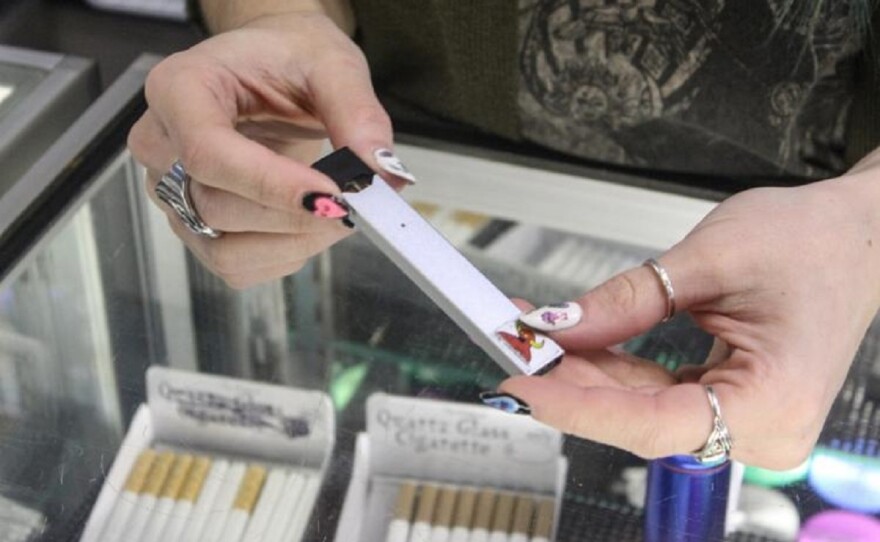As of April 12, Juul Labs must pay Washington, D.C., more than $15 million in a settlement over claims the company marketed their vaping devices toward teenagers. The attorneys general for D.C., New York, California, Illinois, Massachusetts, New Mexico and Colorado alleged that Juul styled its advertisements to cater to young people without highlighting the dangers of vaping.
Although Juul has been pinned as a well-known vape company among teens, other flavored synthetic nicotine devices continue to rise in popularity among this demographic. The Annual National Youth Tobacco Survey reported in 2022 that 1 in 10 high and middle school students in the U.S. currently use e-cigarettes.
“This isn’t just high school students experimenting. These are kids who are becoming addicted to nicotine as a substance,” said Meghan Kissell, who worked until recently as a regional area director at the nonprofit Campaign for Tobacco-Free Kids.
In the 2023 State of Tobacco Control report, the American Lung Association ranked Virginia as one of the worst states for tobacco and nicotine use prevention policies. While Virginia raised the minimum age to buy tobacco and nicotine products to 21 in 2019 and made some recent improvements to cessation services, these changes alone appear to be insufficient to end a new generation of smokers.
Here’s how the report graded Virginia:
- Funding for state tobacco prevention programs: F
- Strength of smoke-free air laws: F
- Level of state tobacco taxes: F
- Coverage and access to services to quit tobacco: D
- Ending the sale of all flavored tobacco products: F
One major attraction to these “new cigarettes” is the flavors. The U.S. Food and Drug Administration banned the sale of flavored cigarettes — except for menthol — in 2009.
As a result, smoking cigarettes meant tasting burning tobacco or maybe a hint of menthol, and a 2020 analysis found smoking rates among youths and young adults dropped. And while menthol cigarettes and flavored cigars have remained on the market, the FDA proposed a rule banning their sale as well in April 2022.
But with vapes, nicotine flavors range from mint to strawberry doughnut.
“Flavored tobacco is very attractive to young people,” said Kissell. “Because of these flavors, the demographic is getting younger and younger.”
While the FDA banned cartridge-based, fruity flavored e-cigarette products in 2020, research found that most users either switched to other flavors or tank-based vapes that can be flavored. And the National Youth Tobacco Survey found disposables — which can also be flavored — were the most common vape devices among youths.
The American Lung Association grades each state’s tobacco control in regulation; treatment for those who quit; taxes on tobacco; media campaigns for tobacco use prevention; and reducing the number of users and age of sale.
Several college students recently told VPM News they began vaping in high school. (Editor's note: Each of the students requested that VPM News only use their first names.)
“It sounds super cliché, but everyone was doing it,” said Lauren, a VCU student who tried vaping in her sophomore year of high school. This was a common answer among this demographic.
Another reason given was that they believed vaping could help cope with personal struggles and mental illnesses, such as anxiety and depression.
“I am a super anxious person … so I thought it would help with my anxiety,” said Chris, a current vape user.
One big question remained after multiple people claimed to have started vaping before they were of legal age: How did they get access to vape devices? Some stated that they were able to get one from an older friend or sibling. However, a few mentioned that the smoke shops near them simply did not check their ID.
“We just had smoke shops that wouldn’t card,” claimed Hunter, an ex-vape user.
According to Aleks Casper, director of advocacy for the American Lung Association, synthetic nicotine is considered a "loophole" under the FDA-administered Tobacco Control Act. Although Virginia requires a license for tobacco wholesalers, that does not apply to retailers or e-cigarette products.
“The state doesn’t even know how many tobacco retailers there are in Virginia,” Kissell said.
A report by the National Library of Medicine said requiring a tobacco retailer license could help reduce the number of teens who smoke or vape, if enforcement is strong. This license could provide funding for compliance checks to see that smoke shops are asking for identification and not selling tobacco and nicotine products to underage customers.
Other proposed solutions to increase Virginia’s low ranking include raising the tobacco and nicotine products tax. According to the American Lung Association, increasing this tax can result in fewer young people starting, more adults quitting and could provide funding for health care programs, like tobacco prevention and cessation programs.
The National Youth Tobacco Survey reported that 85% of middle and high school students who vape use flavored devices, such as fruit and mint. Currently, federal law prohibits the sale of closed system devices from selling flavors, excluding menthol and tobacco, but adding disposables and refillable vapes in this law could greatly reduce the number of teens who smoke.
The Centers for Disease Control and Prevention states that smoking is the leading cause of preventable death in the United States. According to Kissell, other parts of the United States that rank highly in the State of Tobacco Control report like Colorado and Washington, D.C., have successfully enforced some of these proposed prevention policies.
“Virginia can improve its ranking if they choose the health and well-being of its kids and citizens over tobacco products,” she said. “If they can make that choice to choose health over profit, policies will follow.”
Watch VPM News Focal Point, Thursdays at 8 p.m., on VPM PBS or on the PBS App.


